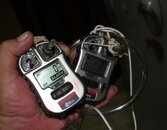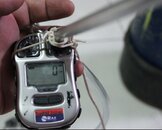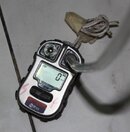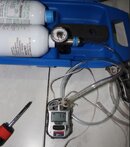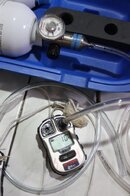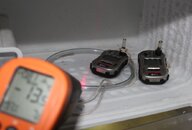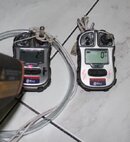The key to having a CO detector for travel is that it be small and lightweight, so that you aren't tempted to leave it behind. It should be robust enough that you can pack it in your suitcase between your thong and Speedo. You don't want to have to bring along another Pelican case.
Personally, I prefer to have a unit that I can calibrate so that I know that I can trust my readings. When I say that the gas is "good" then I want to be sure of that. Likewise, when I say the gas is "bad" then I want to be 100% sure of that, too.
The calibration process is a necessary evil of CO dectectors, at least at this point in time given the technology. Be sure to budget in extra $$$ for the calibration gas and accessories. Use the 10 ppm calgas, not the 100 ppm calgas.
In my opinion, you need a small, robust unit of value that can be calibrated, that gives you a reading in 5 to 15 seconds, and can detect down to 1-2 ppm with a resolution of 1 ppm.
This eliminates the Pocket CO (takes too long), DCO 1001 (takes too long), Analox EII CO (too expensive), Drager Pac CO (resolution unclear) and the CO-Cop (can't be calibrated). THE BW Technologies Gas Alert Extreme is also up there on the expense scale.
I ended up purchasing the BW Technologies Gas Alert Extreme single-gas detector and have been very happy with it. It has a round detector port that fits nicely on either a DIN or Yoke valve. You can also buy an optional sampling hose. It is also robust and water-resistant.
I have my own compressor and I solo with my Voodoo gas, so I got a CO detector many years ago to be sure that I could safely solo with my gas. I take the CO detector with me when I travel.
POCKET CO ($140)
Takes 90 seconds to get a reading (T90=90 sec), detection range only goes down to 5 ppm, spec sheet does not mention resolution/accuracy, needs to be calibrated at least annually ($40 per year extra for calibration gas).
Drager Pac CO ($190) Takes 15 seconds to get a reading, detection range down to 1 ppm with a resolution of 1 ppm, the exact details, cost and schedule of calibration are not clear.
DCO 1001 ($160)
Takes 60 seconds to get a reading, detectin range down to 0 ppm with 20% accuracy but no mention of true resolution, no mention of calibration needs
ToxiRae III ($190)
Takes 12 seconds to get a reading (T90=12 seconds), dectection down to 0 ppm with a resolution of 1 ppm, must be calibrated every 6 months
Analox EII CO ($350)
Takes 20 seconds to get a reading (T90=20seconds?), detection down to 1 ppm with a resoluton of 1 ppm, must be calibrated every 6 months
Co - Cop ($55)
Tests only for "gross contamination" of scuba cylinder air without qualitative measurement
Also consider:
BW Technology Gas Alert Extreme ($265)
Continuous monitoring, detection down to 2 ppm with a resolution of 1 ppm, must be calibrated every 6 months
Personally, I prefer to have a unit that I can calibrate so that I know that I can trust my readings. When I say that the gas is "good" then I want to be sure of that. Likewise, when I say the gas is "bad" then I want to be 100% sure of that, too.
The calibration process is a necessary evil of CO dectectors, at least at this point in time given the technology. Be sure to budget in extra $$$ for the calibration gas and accessories. Use the 10 ppm calgas, not the 100 ppm calgas.
In my opinion, you need a small, robust unit of value that can be calibrated, that gives you a reading in 5 to 15 seconds, and can detect down to 1-2 ppm with a resolution of 1 ppm.
This eliminates the Pocket CO (takes too long), DCO 1001 (takes too long), Analox EII CO (too expensive), Drager Pac CO (resolution unclear) and the CO-Cop (can't be calibrated). THE BW Technologies Gas Alert Extreme is also up there on the expense scale.
I ended up purchasing the BW Technologies Gas Alert Extreme single-gas detector and have been very happy with it. It has a round detector port that fits nicely on either a DIN or Yoke valve. You can also buy an optional sampling hose. It is also robust and water-resistant.
I have my own compressor and I solo with my Voodoo gas, so I got a CO detector many years ago to be sure that I could safely solo with my gas. I take the CO detector with me when I travel.
POCKET CO ($140)
Takes 90 seconds to get a reading (T90=90 sec), detection range only goes down to 5 ppm, spec sheet does not mention resolution/accuracy, needs to be calibrated at least annually ($40 per year extra for calibration gas).
Drager Pac CO ($190) Takes 15 seconds to get a reading, detection range down to 1 ppm with a resolution of 1 ppm, the exact details, cost and schedule of calibration are not clear.
DCO 1001 ($160)
Takes 60 seconds to get a reading, detectin range down to 0 ppm with 20% accuracy but no mention of true resolution, no mention of calibration needs
ToxiRae III ($190)
Takes 12 seconds to get a reading (T90=12 seconds), dectection down to 0 ppm with a resolution of 1 ppm, must be calibrated every 6 months
Analox EII CO ($350)
Takes 20 seconds to get a reading (T90=20seconds?), detection down to 1 ppm with a resoluton of 1 ppm, must be calibrated every 6 months
Co - Cop ($55)
Tests only for "gross contamination" of scuba cylinder air without qualitative measurement
Also consider:
BW Technology Gas Alert Extreme ($265)
Continuous monitoring, detection down to 2 ppm with a resolution of 1 ppm, must be calibrated every 6 months



 Looking forward to comparing it to my Pocket CO, which I did replace after my screwup.
Looking forward to comparing it to my Pocket CO, which I did replace after my screwup.